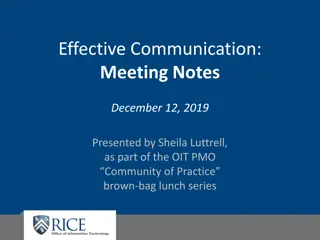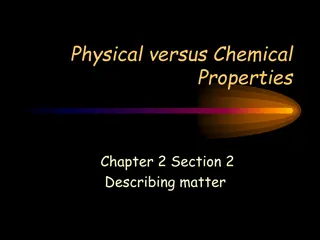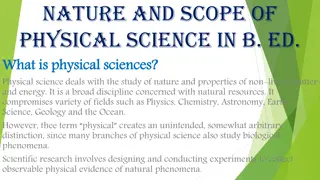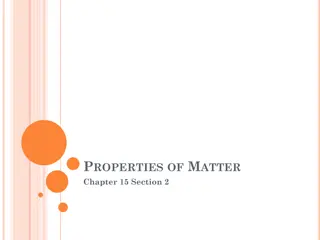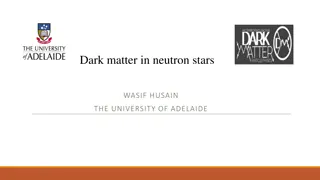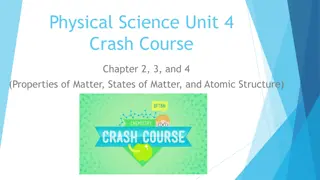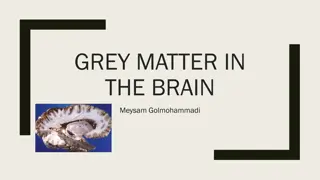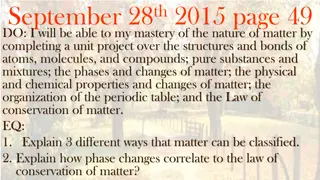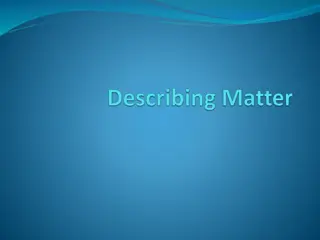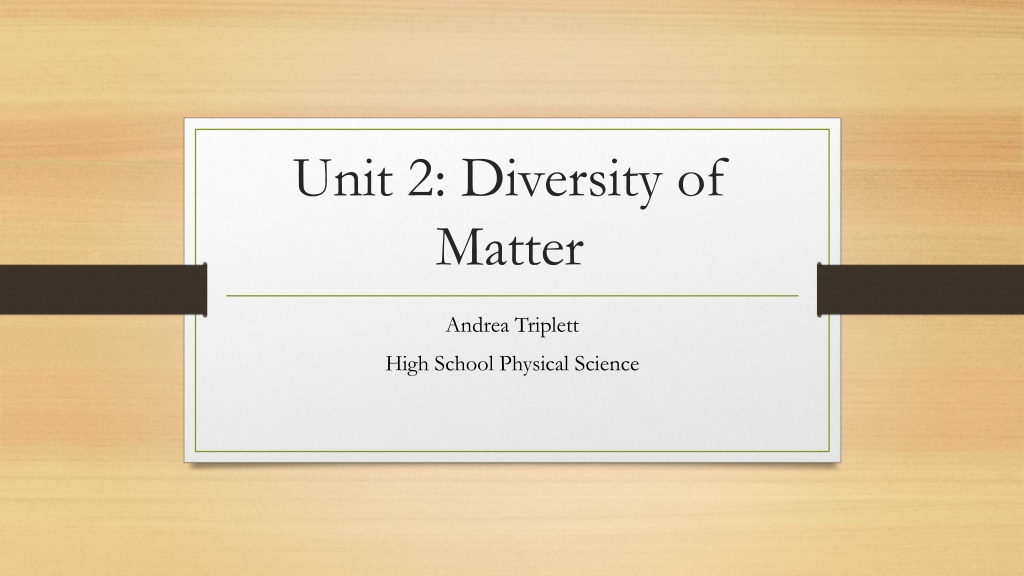
Diversity of Matter in Physical Science
Explore the diversity of matter in physical science through the study of elements, metals, nonmetals, compounds, and their properties. Learn about the characteristics of metals, nonmetals, halogens, noble gases, and more in this comprehensive educational resource.
Download Presentation

Please find below an Image/Link to download the presentation.
The content on the website is provided AS IS for your information and personal use only. It may not be sold, licensed, or shared on other websites without obtaining consent from the author. If you encounter any issues during the download, it is possible that the publisher has removed the file from their server.
You are allowed to download the files provided on this website for personal or commercial use, subject to the condition that they are used lawfully. All files are the property of their respective owners.
The content on the website is provided AS IS for your information and personal use only. It may not be sold, licensed, or shared on other websites without obtaining consent from the author.
E N D
Presentation Transcript
Unit 2: Diversity of Matter Andrea Triplett High School Physical Science
Chapter 19: Elements and their Properties Section 1: Metals Section 2: Nonmetals Lab Identifying Chlorine Compounds in Your Water Section 3: Mixed Groups Lab: Design Your Own Slippery Carbon Page 570 Page 578 Page 580 Page 584 Page 592
Chapter 19 Vocabulary Allotrope Diatomic molecule Ductile Malleable Metal Metallic Bonding Metalloid Nonmetal Radioactive element Salt Semiconductor Sublimation Transition Element Transuranium element
Chapter 19.1 Metals Properties of Metals Metals tend to form ionic and metallic bonds due to low numbers of electrons in their outer energy level. Alkali and Alkaline Earth Metals Elements in Group 1 are called alkali metals. Elements in Group 2 are called alkaline earth metals. Transition Elements and Inner Transition Metals Transition elements are elements in Groups 3-12 in the periodic table. Inner transition elements fit in the periodic table between Groups 3 and 4 in periods 6 and 7.
Chapter 19.1 Review Page 577 1. Describe how to test palladium to see if it is a metal. 2. Explain how arrangement of the iron triad differs from arrangements of coinage metals. 3. Identify how metallic bonds differ from ionic and covalent bonds. 4. Think Critically: If X stands for a metal, how can you tell from the following formulas- XCL and XCL2-which compounds contains an alkali metal and which contains an alkaline earth metal? 5. Use Percentages: Pennies used to be made of copper and zinc, and weighed 3.11g. Today, pennies are made of copper-plated zinc, and weighs 2.5g. A new penny weighs what percent of an old penny?
Chapter 19.2: Nonmetals Properties of Nonmetals Nonmetals usually are gases or brittle solids that are not shiny and do not conduct heat or electricity. Hydrogen Hydrogen makes up 90 percent of the atoms in the universe and is highly reactive. Halogens Halogens are in Group 17 and are highly reactive in their elemental form. The Noble Gases Noble gases exist only as isolated atoms because their outer energy levels are full.
19.2 Review Page 582 1. Describe two ways in which hydrogen combines with other elements. 2. Rank the following nonmetals from lowest number of electrons in the outer level to highest: CL-, H+, He, H. 3. Explain how solid nonmetals are different from solid metals. 4. Describe how you can tell that a gas is a halogen. 5. Think Critically: What is the process of a solid changing directly into a vapor? Which element undergoes this process at room temperature? 6. Interpret data by identifying the nonmetal with its oxidation number in these compounds: MgO, NaH, AlBr3, and FeS.
19.2 Lab: Identifying Chlorine Compounds in Your Water Page 580 Procedure 1. In three labeled test tubes, obtain 2 mL of chlorine standard solution, distilled water, and drinking water. 2. Carefully add five drops of silver nitrate solution to each and stir. Warning: Avoid contact with the silver nitrate solution. Silver nitrate is a corrosive liquid that can stain skin and clothes. Analysis 1. Which solution will definitely show a presence of chlorine? How did this result compare to the result with distilled water? 2. Which result most resembled your drinking water?
Chapter 19.3: Mixed Groups Properties of Metalloids Metalloids are elements that can form ionic and covalent bonds with other elements and can have metallic and nonmetallic properties. Carbon Group The elements in Group 14 have four electrons in their outer energy levels. Nitrogen Group The elements in Group 15 tend to share electrons and form covalent bonds. Synthetic Elements Synthetic elements are elements that are not typically found on Earth. By synthesizing elements, scientists may understand how the forces inside the atom work.
Chapter 19.3 Review Page 591 1. Explain why Groups 14 and 15 are better representatives of mixed groups than Groups 13 and Group 16. 2. Describe how allotropes of silicon differ in appearance. 3. Explain how an element is classified as a transuranium element. 4. Describe what type of structure a diamond has. How would you build a model of this? 5. Think Critically: Graphite and a diamond are both made of the element carbon. Why is graphite a lubricant and diamond the hardest gem known? 6. Calculate: Element 114 lasted 30s before falling apart. It lasted 100,000 times longer than element 112. How long did element 112 last?
19.3 Lab Slippery Carbon Page 592-593 Real World Question Often, a lubricant is needed when two metals touch each other. For example, a sticky lock sometimes works better with the addition of a small amount of graphite. What gives this allotrope of carbon the slippery property of a lubricant? Why do certain arrangements of atoms in a material cause the material to feel slippery? Form Your Hypothesis Based on your understanding of how carbon atoms bond, form a hypothesis about the relationship of graphite s molecular structure to its physical properties.
19.3 Lab Slippery Carbon Page 592-593 Test Your Hypothesis 1. As a group, agree upon a logical hypothesis statement. 2. As a group, sequence and list the steps you need to take to test your hypothesis. Be specific, describing exactly what you will do at each step to make a model of the types of bonding present in graphite. 3. Remember from Figure 18 that graphite consists of rings of six carbons bonded in a flat hexagon. These rings are bonded to each other. In addition, the flat rings in one layer are weakly attached to other flat layers. 4. List possible materials you plan to use. 5. Read over the experiment to make sure that all steps are in logical order. 6. Will your model be constructed with materials that show weak and strong attractions? Follow Your Plan 1. Make sure your teacher approves your plan before you start. 2. Have you selected materials to use in your model that demonstrate weak and strong attractions? Carry out the experiment as planned. 3. Once your model has been constructed, list any observations that you make and include a sketch in your Science Journal.
19.3 Lab Slippery Carbon Page 592-593 Analyze Your Data 1. Compare your model with designs and results of other groups. 2. How does your model illustrate two types of attractions found in the graphite structure? 3. How does the bonding of graphite that you explored in the lab explain graphite s lubricating properties? Write your answers in your Science Journal. Conclude and Apply 1. Describe the results you obtained from your experiment. Did the results support your hypothesis? 2. Describe why graphite makes a good lubricant. 3. Explain what kinds of bonds you think a diamond has.
Chapter 19 Study Guide Section 1: Metals 1. A typical metal is a hard, shiny solid that, due to metallic bonding, is malleable, ductile, and a good conductor. 2. Groups 1 and 2 are the alkali and alkaline earth metals, which have some similar and some contrasting properties. 3. The iron triad, the coinage metals, and the elements in Group 12 are examples of transition elements. 4. The lanthanides and actinides have atomic numbers 58-71 and 90 through 103, respectively.
Chapter 19 Study Guide Continued Section 2: Nonmetals 1. Nonmetals can be brittle and dull. They are also poor conductors of electricity. 2. As a typical nonmetal, hydrogen is a gas that forms compounds by sharing electrons with other nonmetals and by forming ionic bonds with metals. 3. All the halogens, Group 17, have seven outer electrons and form covalent and ionic compounds, but each halogen has some properties that are unlike each of the others in the group. 4. The noble gases, Group 18, are elements whose properties and uses are related to their chemical stability. Section 3: Mixed Groups 1. Groups 13 through 16 include metals, nonmetals, and metalloids. 2. Allotropes are forms of the same element having different molecular structures. 3. The properties of three forms of carbon-graphite, diamond, and Buckminster-fullerene-depend upon the differences in their crystal structures. 4. All synthetic elements are short-lived. Except for technetium-43 and promethium-61, they have atomic numbers greater than 92 and are referred to as transuranium elements. These elements are found toward the bottom of the periodic table.
Chapter 20: Chemical Bonds Section 1: Stability in Bonding Lab: Atomic Trading Cards Section 2: Types of Bonds Section 3: Writing Formulas and Naming Compounds Lab: Design Your Own Become a Bond Breaker Page 602 Page 607 Page 608 Page 615 Page 622
Chapter 20: Vocabulary Page 615 Page 606 Page 603 Page 611 Page 620 Page 608 Page 610 Page 611 Page 614 Page 615 Page 614 Page 619 Binary Compound Chemical Bond Chemical Formula Covalent Bond Hydrate Ion Ionic Bond Molecule Nonpolar Molecule Oxidation Number Polar Molecule Polyatomic Ion
Chapter 20.1: Stability in Bonding Combined Elements When elements combine, the new compound has unique properties that are different from the original properties of the elements. Formulas Chemical symbols and numbers are shorthand for the elements and their amounts in chemical formulas. Atomic Stability The elements of Group 18, the noble gases, rarely combine with other elements. Electron dot diagrams show the electrons in the outer energy level of an atom. Most atoms need eight electrons to complete their outer energy level. Atoms form chemical bonds in three separate different ways to complete their outer energy levels. A chemical bond is the force that holds atoms together in a compound.
Chapter 20.1: Stability in Bonding Page 606 1. Compare and contrast the properties of the individual elements that combine to make salt with the compound salt. 2. Identify what the formula BaF2 tells you about this compound. 3. Identify the forces that hold atoms and molecules together at the atomic level. Give an example of how these forces are involved in a chemical reaction. 4. Explain why some elements are stable on their own while others are more stable in compounds. 5. Describe why chemical bonding occurs. Give two examples of how bonds can form. 6. Think Critically: The label on a box of cleanser states that it contains CH3COOH. What elements are in this compound? How many atoms of each element can be found in a unit of CH3COOH? 7. Use Percentages: Given that the molecular weight of Mg(OH)2, magnesium hydroxide, is 58.32 g, what percentage of this compound is oxygen?
20.1 Lab: Atomic Trading Cards Page 607 Procedure 1. Get an assigned element from the teacher. Write the following information for your element on your index card: name, symbol, group number, atomic number, atomic mass, metal/nonmetal/metalloid. 2. On the other side of your index cards, show the number of protons and neutrons in the nucleus (e.g. 6p for six protons and 6n for six neutrons for carbon.) 3. Draw circles around the nucleus to represent the energy levels of your element. The number of circles you will need is the same as the row the element is on the periodic table. 4. Draw dots on each circle to represent the electrons in each energy level. Remember, the elements in row one become stable with two outer electrons while levels two and three become stable with eight electrons. 5. Look at the picture side only of four or five of your classmates cards. Determine which element they have and to which group it belongs. Conclude and Apply 1. As you classify the elements according to their group number, what pattern do you see in the number of electrons in the outer energy level? 2. Atoms that give up electrons combine with atoms that gain electrons in order to form compounds. In your Science Journal, predict some pairs of elements that would combine in this way.
Chapter 20.2: Types of Bonds Gain or Loss of Electrons An ion is a charged particle that has either fewer or more electrons that protons, resulting in a negative or positive charge. Ionic Bond An ionic bond is the force or attraction between opposite charges of ions in an ionic bond. An ionic compound is neutral because the sum of the ion charges is zero. Sharing Electrons Some atoms, like those in Group 4, share electrons instead of losing or gaining them. Covalent bonds can form single, double, or triple bonds. In a polar molecule the electrons are shared unequally in the bond. This results in slightly charged ends. Electrons are shared equally in a nonpolar molecule.
Chapter 20.2 Review Page 614 1. Explain why an atom makes an ionic bond only with certain other atoms. 2. Compare and contrast the possession of electrons in ionic and covalent bonds. 3. Name the types of particles formed by covalent bonds. 4. Think Critically: From the following list of symbols, choose two elements that are likely to form an ionic bond: O, Ne, S, Ca, K. Next, select two elements that would likely form a covalent bond. Explain. 5. Concept Map: Using the following terms, make a network-tree concept map of chemical bonding: ionic, covalent, ions, positive ions, negative ions, molecules, polar, and nonpolar. 6. Solve One-Step Equations: Aluminum oxide, Al2O3, can be produced during space shuttle launches. Show that the sum of the positive and negative charges in a unit of Al2O3 equals zero.
Chapter 20.3: Writing Formulas and Naming Compounds Binary Ionic Compounds A binary compound is one composed of two elements. The oxidation number tells how many electrons an atom has gained, lost, or shared to become stable. The net charge of a compound is zero. Compounds with Complex Ions A polyatomic ion is a positively or negatively charged, covalently bonded group of atoms. A hydrate is a compound that has water chemically attached to its ions. Greek prefixes are used to indicate how many atoms of each element are in a binary covalent compound.
Chapter 20.3: Writing Formulas and Naming Compounds Page 621 1. Use Formulas: Write formulas for the following compounds: potassium iodide, magnesium hydroxide, aluminum sulfate, and chlorine heptoxide. 2. Use Formulas: Write the names of these compounds: KCl, Cr2O3, Ba(ClO3)2, NH4Cl, and PCl3. 3. Name Mg3(PO4)2 *4H2O, and write the formula for calcium nitrate trihydrate. 4. Think Critically: Explain why sodium and potassium will or will not react to form a bond with each other. 5. Solve One-Step Equations: The overall charge on the polyatomic sulfate ion, found in some acids, is 2-. Its formula is SO4^2-. If the oxygen ion has a 2- oxidation number, determine the oxidation number of sulfur in this polyatomic ion.
20.3 Lab: Become a Bond Breaker Page 622-623 Real-World Question The basic structural units of ionic compounds are ions. For covalent substances, molecules make up the basic units. By using controlled heat to melt substances, you can test various compounds to rate the attractive forces between their basic units. Would a substance that is difficult to melt have strong forces or weak forces holding its basic units together? How do the attractive forces between ions compare to the attractive forces between molecules? Form a Hypothesis Based on what you know about ions and molecules, state a hypothesis about which generally would have stronger attractions between their structural units.
20.3 Lab: Become a Bond Breaker Page 622-623 Test your Hypothesis Make a Plan 1. As a group, agree upon and write a hypothesis statement. 2. As a group, write a detailed list of steps that are needed to test your hypothesis. Determine what your control will be. 3. As you heat materials in a test tube, what variables are held constant? 4. How will you time the heating of the individual substances? 5. Will you run any test more than one time? 6. Make a list of materials that you will need to complete your experiment. 7. Design a data table in your Science Journal to record your observations. 8. Make sure your teacher approves your plan before you start. Follow Your Plan 1. Carry out the experiment exactly as planned. 2. While you are observing the heating of each substance, think about the movement of the particles. Which particles are held together by ionic bonds? Which are made up of covalent molecules? How does that affect their movement? 3. Be sure to write down exactly how long it takes to melt each tested substance.
20.3 Lab: Become a Bond Breaker Page 622-623 Analyze Your Data 1. Compare your results with those of other groups in the class. 2. Classify your tested substances as more likely ionic or covalent. 3. Which substances are generally more difficult to melt? 4. Did you have a control in this experiment? Variables? Conclude and Apply 1. Think Critically: How did the results of your experiment support or disprove your hypothesis? 2. Infer: Sugar is known as a polar covalent compound. Knowing this, infer from your results how polarity affects melting point.
Chapter 20 Study Guide Section 1: Stability in Bonding 1. The properties of compounds are generally different from the properties of the elements they contain. 2. A chemical formula for a compound indicates the composition of a unit of the compound. This model of a water molecule shows the shape of the molecule and the relative size of the atoms. 3. Chemical bonding occurs because atoms of most elements become more stable by gaining, losing, or sharing electrons in order to obtain a stable outer energy level. Section 2: Types of Bonds 1. Ionic bonds between atoms are formed by the attraction between ions. Covalent bonds are formed by the sharing of electrons. Below is an example of an ionically bonded compound. 2. Ionic bonding occurs between charged particles called ions and produces ionic compounds. Covalent bonding produces units called molecules and occurs between nonmetallic elements. 3. The unequal sharing of electrons produces compounds that contain polar bonds, and the equal sharing of electrons produces nonpolar compounds.
Chapter 20 Study Guide Section 3: Writing Formulas and Naming Compounds 1. An oxidation number indicates how many electrons an atom has gained, lost, or shared when bonding with other atoms. 2. In the formula of an ionic compound, the element or ion with the positive oxidation number is written first, followed by the one with the negative number. 3. The name of a binary compound is derived from the names of the two elements that compose the compound. Salt is an example of a binary compound. 4. A hydrate is a compound that has water chemically attached to its ions and written into its formula. 5. Greek prefixes are used in the names of covalent compounds. These indicate the number of each atom present.
Chapter 21: Chemical Reactions Section 1: Chemical Changes Section 2: Chemical Equations Section 3: Classifying Chemical Reactions Section 4: Chemical Reactions and Energy Lab: Catalyzed Reaction Lab: Use the Internet Fossil Fuels and Greenhouse Gases Page 632 Page 637 Page 640 Page 646 Page 651 Page 652
Chapter 21 Vocabulary Balanced chemical equation Catalyst Chemical equation Chemical reaction Coefficient Combustion reaction Decomposition reaction Double-displacement reaction Endergonic reaction Endothermic reaction Exergonic reaction Exothermic reaction Inhibitor Oxidation Precipitate Product Reactant Reduction Single-displacement reaction Synthesis reaction
Chapter 21.1: Chemical Changes Describing Chemical Reactions A chemical reaction is a process that involves one or more reactants changing into one or more products. Conservation of Mass A basic principle of chemistry is that matter, during a chemical change, can neither be created nor destroyed. Antonie Lavoisier is often considered to be the father of modern chemistry for his work in defining the law of conservation of mass. Writing Equations Chemical equations describe the change of reactants to products and obey the law of conservation of mass. Unit Managers Coefficients represent how many units of each substance are involved in a chemical reaction.
Chapter 21.1: Review Page 637 1. Identify the reactants and the products in the following chemical equation. 2. Identify the state of matter of each substance in the following reaction. 3. Explain why the reaction of oxygen with iron is a problem, but the reaction of oxygen with aluminum is not. 4. Explain the importance of the law of conservation of mass. 5. Think Critically: Why do you think the copper patina was kept when the Statue of Liberty was restored?
Chapter 21.2: Chemical Equations Balanced Equations A chemical equation is a way to indicate reactants and products and relative amounts of each. A balanced chemical equation tells the exact number of atoms involved in the reaction. Balanced chemical equations must satisfy the law of conservation of matter; no atoms of reactant or product can be lost from one side to the other. Coefficients are used to achieve balance in a chemical equation. Chemical equations cannot be balanced by adjusting the subscript numerals in compound names because doing so would change the compounds.
Chapter 21.2: Review Page 640 1. Describe two reasons for balancing chemical equations. 2. Balance this chemical equation: 3. Explain why oxygen gas must always be written as O2 in a chemical equation. 4. Infer: What coefficient is assumed if no coefficient is written before a formula in a chemical equation? 5. Think Critically: Explain why the sum of the coefficients on the reactant side of a balanced equation does not have to equal the sum of the coefficients on the product side of the equation. 6. Use Numbers: Balance the equation for the reaction below.
Chapter 21.3: Classifying Chemical Reactions Types of Reactions Chemical reactions are organized into five basic classes: combustion, synthesis, decomposition, single displacement, and double displacement. Lavoisier was one of the first scientists to accurately describe a combustion reaction. For single-displacement reactions, we can predict which metal will replace another by comparing the activity characteristic of each. Some reactions produce a solid called a precipitate when two ionic substances are combined. Oxidation-Reduction Reactions Oxidation is the loss of electrons and reduction is the corresponding gain of electrons. Redox reactions often result in corrosion and rust. A substance that gains elections is reduced, and a substance that loses elections is oxidized.
Chapter 21.3: Review Page 645 1. Classify each of the following reactions. 2. Describe what happens in a combustion reaction. 3. Explain the difference between synthesis and decomposition reactions. 4. Determine, using Figure 13, if zinc will displace gold in a chemical reaction and explain why or why not. 5. Think Critically: Describe one possible economic impact of redox reactions. How might that impact be lessened?
Chapter 21.4: Chemical Reactions and Energy Chemical Reactions-Energy Exchanges Chemical reactions release or absorb energy as chemical bonds are broken and formed. The energy of chemical reactions can be in the form of thermal energy, light, sound, and/or electricity. Catalysts are used to increase the chemical reaction rate. Chemical Energy Chemical reactions that release energy are called exergonic. Chemical reactions that absorb energy are called endergonic. Exothermic reactions give off thermal energy. Endothermic reactions absorb energy in the form of thermal energy. Exothermic reactions provide most of the power used in homes and industries.
Chapter 21.4: Review Page 650 1. Classify the chemical reaction photosynthesis, which requires energy to proceed, as endergonic or exergonic. 2. Explain why a catalyst is not considered a reactant or product in a chemical reaction. 3. Explain why crackers containing BHT stay fresh longer than those without it. 4. Classify the reaction that makes a firefly glow in terms of energy input or output. 5. Think Critically: To develop a product that warms people s hands, would you choose an exothermic or endothermic reaction to use? Why? 6. Calculate: If an endothermic reaction begins at 26C and loses 2C per minute, how long will it take to reach 0C?
21.4 Lab Catalyzed Reaction Page 651 Real World Question How does the presence of a catalyst affect the rate of a chemical reaction? Procedure 1. Label three test tubes and set them in a test-tube stand. Pour 5 mL of hydrogen peroxide into each tube. 2. Place about teaspoon of sand in tube 2 and the same amount of MnO2 in tube 3. 3. In the presence of a catalyst, H2O2 decomposes rapidly producing oxygen gas, O2. Test each tube by: Lighting a wooden splint, blowing out the flame, and inserting the glowing splint into the tube. The splint will relight if oxygen is present. 4. Place all three tubes in a beaker of hot water. Heat on a hot plate until all of the remaining H2O2 is driven away and no liquid remains. Conclude and Apply 1. Observe the changes that happened when the solids were added to the tubes. 2. Infer which substance, sand, or MnO2, was the catalyst. 3. Identify what remained in each tube after the H2O2 was driven away.
Chapter 21 Study Guide Section 1: Chemical Changes 1. In a chemical reaction, one or more substances are changed to new substances. 2. The substances that react are called reactants, and the new substances formed are called products. Charcoal, the reactant shown below, is almost pure carbon. 3. The law of conservation of mass states that in chemical reactions, matter is neither created nor destroyed, just rearranged. 4. Chemical equations efficiently describe what happens in chemical reactions. Section 2: Chemical Equations 1. Balanced chemical equations give the exact number of atoms involved in the reaction. 2. A balanced chemical equation has the same number of atoms of each element on both sides of the equation. This satisfies the law of conversation of mass. 3. When balancing chemical equations, change only the coefficients of the formulas, never the subscripts. To change a subscript would change the compound.
Chapter 21 Study Guide Section 3: Classifying Chemical Reactions 1. In synthesis reactions, two or more substances combine to form another substance. 2. In single-displacement reactions, one element replaces another in a compound. 3. In double-displacement reactions, ions in two compounds switch places, often forming a gas or insoluble compound. 4. Using the activity series chart, scientists can determine which metal can replace another metal. Section 4: Chemical Reactions and Energy 1. Energy in the form of light, thermal energy, sound or electricity is released from some chemical reactions known as exergonic reactions. This flame releases light and thermal energy. 2. Reactions that absorb more energy than they release are called endergonic reactions. 3. Reactions may be sped up by adding catalysts and slowed down by adding inhibitors. 4. When energy is released in the form of thermal energy, the reaction is exothermic.





